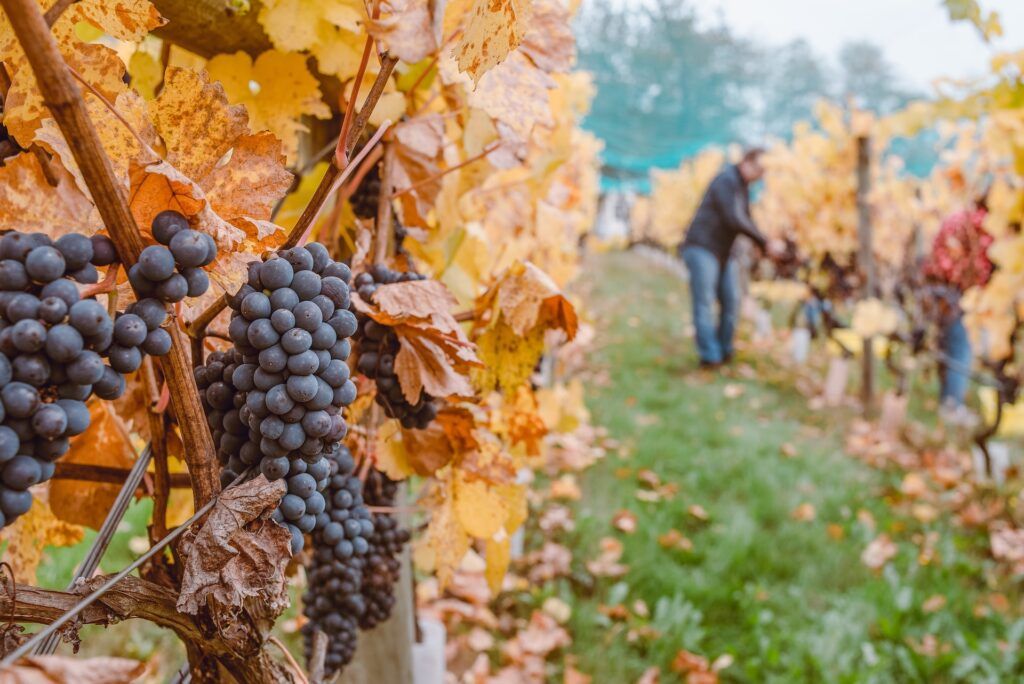A glass of wine with your climate crisis?
By Jessica McKenzie | September 26, 2023
 Photo by Tina Witherspoon on Unsplash
Photo by Tina Witherspoon on Unsplash
“What do you think happened to this wine?”
I turned my attention to the bright cerise liquid in the last of our five glasses. It was lighter than the other two reds on the table. I took a sip, my amateur tongue probing for tasting notes that might reveal what climate trauma these grapes endured. Someone else beat me to it: “Smoke.”
After it was pointed out, I sensed it immediately: a bouquet of barbecue, a soupçon of combustion.
This was the 2020 Cloudline Pinot Noir from Oregon’s Willamette Valley. Oregon’s 2020 wildfire season was one of the most destructive in the state’s history, burning well over a million acres and killing 11 people. Nearly every wine-producing region in the state was impacted by either fire or smoke drift.
When the free volatile phenols produced by burning wood come into contact with grape skin, they can bind to the fruit’s sugars and create glycosides, which are usually odorless and tasteless. But fermentation can re-release those volatile phenols into the wine. This can result in what’s known as smoke taint.
“It’s like licking a wet ashtray,” said Jasmine Spiess, the events and marketing manager of ClimateAi, the company hosting the climate change wine tasting event.
Smoke taint can be minimized by producing mostly white (or rosé) wine, which limits the amount of skin contact (red wines are fermented with the grape skins, while white wines are not). In this case, Spiess said the makers of Cloudline let the autumn rains wash the smoke off, or sprayed them off themselves, and then pressed out the juice very gently. The result is only the faintest trace of ashtray.
Wildfire smoke is just one of the hazards that traditional winemaking regions are more likely to experience due to climate change. At the same time, because of global warming, new regions are becoming more suitable for vineyards. This duality was the organizing principle behind ClimateAi’s climate-influenced wine tasting in New York last week, which featured two endangered wines and two emerging wines. Our fifth glass, the Cloudline pinot noir, was the surprise wildcard.
We sampled the 2018 Gusbourne Brut Reserve, an extraordinarily bright and lively sparkling wine from Kent, which has a soil like that of Champagne. As the climate warms, the United Kingdom will become increasingly competitive as a winemaking region, along with Belgium, the Netherlands, Sweden, and, in the southern hemisphere, Tasmania and Uruguay.
On the other hand, France’s Champagne region is coming under increasing climate pressures. In 2021, French winemakers faced a series of disasters: After an early frost, mildew, and multiple hailstorms, as much as 60 percent of Champagne grapes were lost.
We tried a non-vintage brut reserve by Duval-Leroy, a soft, mild champagne reminiscent of French pastry. This amateur oenophile had to look up the term, but non-vintage means the wine was made from grapes grown in different years. Apparently, most champagne is non-vintage, according to Wine Enthusiast. This has helped winemakers maintain consistency from year to year, even as the weather fluctuates. But with climate change, blending grapes from different years may not be enough to ensure quality and consistency. Winemakers are adapting by changing recipes and using mitigation strategies like shade nets and particle film (which is kind of like sunscreen for plants). Even so, it’s apparent that the champagne of the future will not be the champagne of the past.
Similarly, the flavor of red wines is starting to all blend (pun intended) together. “The problem is that with a warming climate, these red grapes start to all taste the same,” Spiess said. “Kind of like cooked raisins.”
Spiess appealed to a sommelier in the room, who confirmed that this has made the sommelier examination even harder. “They’re so high in alcohol that it really kills your nose,” she said. “You can’t smell anything else or taste anything else.”
To adapt, Spiess said winemakers are increasingly growing new(er) varieties of grapes that can produce dry, bitter, and mineral flavor profiles, like marselan, a cross between cabernet sauvignon and grenache first bred in the 1960s. Marselan also has the advantage of having good disease resistance, which sets it up to be a popular choice in the coming decades. We tried the 2020 Bodega Garzón Uruguay Reserve Marselan, a single varietal wine that was very dry: like tobacco and rocks.
In contrast, the 2020 Justin cabernet sauvignon was almost jammy, especially after the marselan. Maybe it was the power of suggestion, knowing this was the ‘endangered’ wine, but it tasted a bit of boozy cooked fruit.
Justin Vineyards and Winery is a subsidiary of The Wonderful Company—which also owns the juice company Pom and the bottled water company Fiji—and Wonderful is a client of ClimateAi.
ClimateAi uses machine learning to help the agricultural industry anticipate different climate hazards and forecast future yields. Spiess said ClimateAi can help growers make informed short- and long-term decisions by revealing the regions likely to be the most conducive to growing specific plants or varietals, and what plants and varietals will thrive in a particular place.
It felt rather frivolous to be getting tipsy in midtown on a Tuesday afternoon in the middle of New York City’s Climate Week, when over a hundred climate activists were arrested for protesting at the Museum of Modern Art and the Federal Reserve Bank of New York, and tens of thousands of activists marched to demand an end to fossil fuels.
I mean, “endangered” wine: what a first-world problem, right? Yes, and no. Climate change threatens wine growers and workers and entire communities and regions, in addition to wealthy (and not-so-wealthy) wine drinkers.
ClimateAi CEO Himanshu Gupta said the wine tasting is a way to help people see how the climate crisis will impact them and to prove that it is not a problem for 2050, but for right now. Of course, anyone who needs this proven with a wine tasting is privileged, but I suspect Gupta and Spiess are often preaching to the choir.
Mike Hoffmann, Danielle Eiseman, and Jonathon Schuldt have previously written in the Bulletin that the threat climate change poses to beloved foods like coffee, chocolate, beer, and wine is a bipartisan issue, an area of common ground. For that reason, a wine tasting is not a bad way to start a conversation about climate risk and adaptation. “As a fellow marketer, this is genius,” a communications manager of yet another ag-tech company—who happened to sit down at my tasting table—told Spiess.
Wine is just one of many agricultural (and cultural) products threatened by climate change. Spiess said she has also led tasting events centered around millet, a nutritional and drought-resistant grain, which could help make the global food system more resilient in face of climate change. The United Nations even declared 2023 the “international year of millets.”
Like the canary in the coal mine, the champagne in the wine cellar is a warning, a sign of bigger climate crises to come. If ClimateAi can get people to pay attention—well, I’ll drink to that.
Together, we make the world safer.
The Bulletin elevates expert voices above the noise. But as an independent nonprofit organization, our operations depend on the support of readers like you. Help us continue to deliver quality journalism that holds leaders accountable. Your support of our work at any level is important. In return, we promise our coverage will be understandable, influential, vigilant, solution-oriented, and fair-minded. Together we can make a difference.
Keywords: agricultural production, agriculture, climate awareness, climate crisis, food systems, wine
Topics: Climate Change















Alcohol is cancer causing. There is not ‘tolerable’ limit. There is no ‘red wine benefit’, there is no ‘lower blood pressure’ benefit. Cheers!